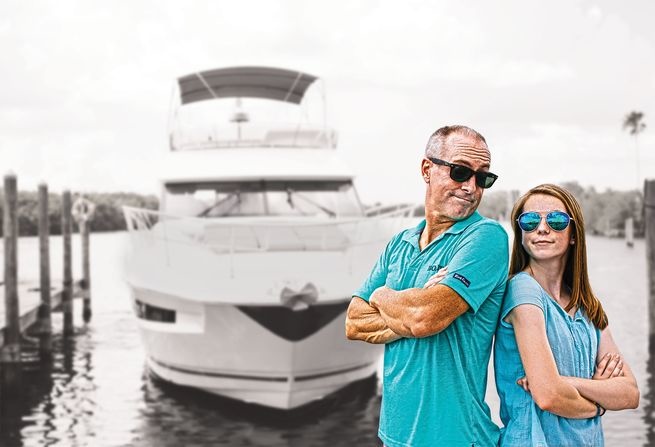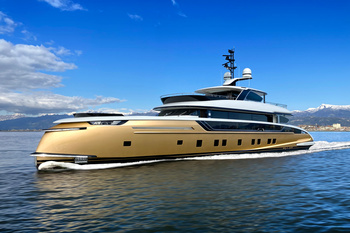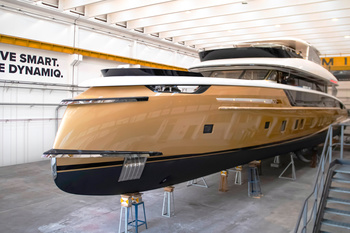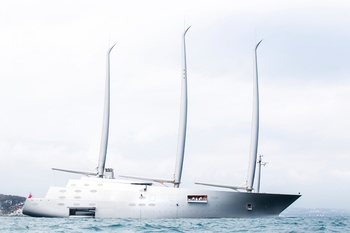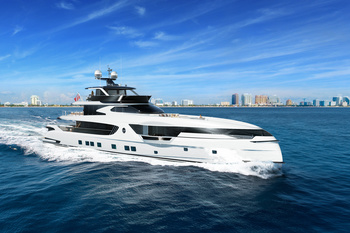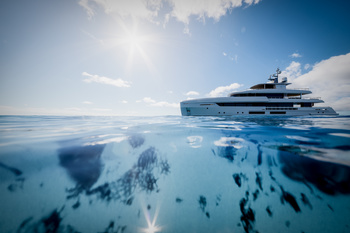She barely turned thirteen and received her yachting certificate just a few weeks ago. At the helm of a 46-foot
To moor this snow-white beauty, the girl did not have to master the art of skillfully juggling the gas/reverse handles of two engines for several hours. Hell, in the time she spent on board, she didn't even touch them. All she needed was a joystick and a ten-minute briefing. That's a very familiar device to today's teenagers. However, mooring a boat is not a video game, and I'm going to prove it.
Welcome to Boating's Joystick Challenge, a competition between a beginner and an experienced skipper in the ability to moor a boat with a joystick. Meet the participants! Riley Hemmel, aka Riley Hemmel, grew up among boats, but never stood behind the wheel of anything
In the other corner of the ring, me, her father is the guy who has been testing boats for Boating magazine for almost 25 years. But to be honest, I usually have to deal with half the size of an outboard engine or tilt&turn column.
It is worth saying a special thanks for the boat for this experiment - 46 Prestige Yacht. It was kindly provided by Galati Yacht Sales of
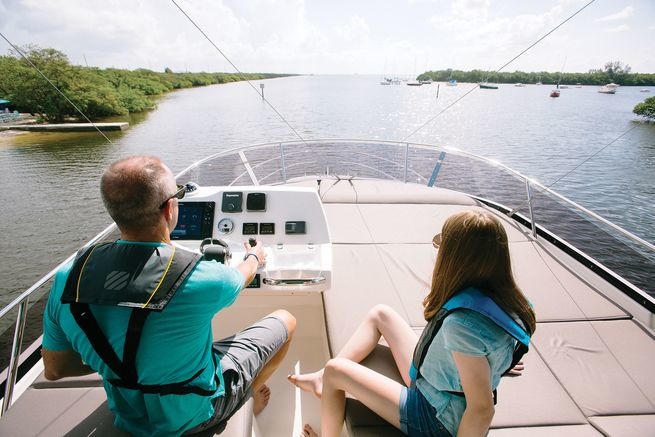
So, I just have to win! No matter how much experience I have in running two engines. I have moored a huge number of boats, so I have an undeniable advantage: I am times better able to assess the impact of wind and currents. In addition, I am a calm, balanced adult.
And Riley? She's a teenager, an irrational life form prone to impulsive acts and wild mood swings. Okay, wait, wait, she can read this. Then let's put it this way: a form of life that is certainly delightful, but slightly lacking in judgment and patience to perform such complex tasks.
However, as they say, in love and in war all methods are good, and I am ready to take any chance. When she sits down at the post of government, I wish her luck, and in the meantime discreetly move the bimini to shine the ruthless August sun of Florida in her face. You know, baby, I love you, but if you can't handle the heat, get off the flybridge.
Daddy's not up for games right now.
Control subtleties
Even though this is the first time my daughter has ever seen a boat operated by a joystick, the Inboard Performance System (IPS) from Volvo Penta has been in place since 2005. It was then that a renowned engine manufacturer stunned the public with a revolutionary propulsion system with two counter-rotating screws pointing forward.
From the first trials of this baby in the real world, it became clear that the marketers of Volvo Penta have not in vain created such a fuss around her. Thanks to the fact that the rotary-wing loudspeakers are located directly under the engines, there is more useful space on board. Noise and vibration levels were significantly reduced, but efficiency at high speeds increased by 35% - all thanks to the fact that the forward propellers work in calm water. With IPS, it is now possible to use less powerful engines without losing performance.
However, one of the most important practical advantages of IPS was its stunning agility at low speed. The rotary loudspeakers, which can move independently of each other at an angle of up to 30 degrees, create traction in almost any direction. With IPS, just turn the joystick to the direction the boat should go, and the propulsion system (and special smart programs) will do the rest. The boat can turn in any direction, turn 360 degrees on the spot and even move sideways, mooing neatly into the free space at the berth in the crowded marina. In short, driving a huge multi-motor yacht has become almost, I'm not afraid of that word, elementary.
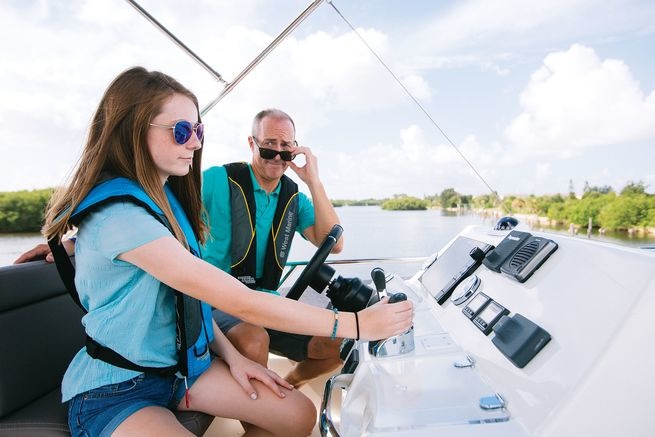
As you'd expect, Riley got used to it fast. I'll open up all the cards. Except for the rare sessions she had with Nintendo Wii, she wasn't one of the teenagers who grew up playing video games (and I can't believe we even did that). But operating the boat with the joystick is so intuitive that even a novice yachtsman only needs to complete this ridiculously short training once.
A few minutes later, our instructor Alex Kramer from Galati Yacht Sales gave the control to Riley. And now it already passes through a narrow channel, turns 180 degrees, moves sideways and reverses - just like an experienced pro.
Yeah, I took that express course, too (don't tell Riley, but I've dealt with joysticks on boats before), but I immediately realized that I shouldn't relax. As I said, she's good and despite my bimini trick, still not even a drop of sweat. Wow, that's cold blood!
The show's starting.
The first competition was very easy: we had to walk from Galati Yacht's docks through a calm channel, where there was not even a hint of somebody's culvert
The boat's 180 degree turn was also equally good for both of us. A simple circular movement of the joystick caused the boat to rotate almost in place. In addition, we made a turn first at the front and then at the rear. Each time, the IPS ride adjusts its direction and tractive power to execute our commands with jewelry accuracy.
We were both able to keep the boat in place for a given time, despite the wind and current. It wasn't difficult thanks to Volvo Penta's Dynamic Positioning System (DPS) - all we had to do was push a button and the wind-wheel speakers, paired with the GPS, did the rest. But still, it's worth noting that in the open water, the shallow one felt like he was in his native environment.
For the next tests we headed for the floating concrete docks of Galati Yacht. Before turning in their direction, I kind of accidentally asked Kramer about the price of the boat, and then in a conversation several times stressed how disgusting the crunch of broken fiberglass is.
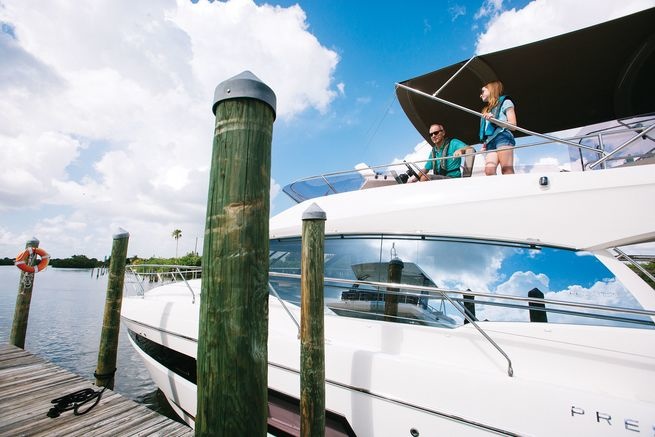
The next task was to moor the boat parallel to the berth, moving strictly sideways. This competition required a little more skill and restraint than the previous ones. We had previously agreed that the test would only be considered successful if the helm was strictly against the notional mark on the pier. Otherwise, the participant was expected to fail, not to mention the possibility of encountering a
Anyway, we both did a great job, technically stopping the boat a few inches from the dock. Again, it was very easy to do with IPS. The boat obediently moved in the direction where we turned the joystick. By pushing the handle harder, we gave in to the gas, thus increasing speed. As the bow of the boat began to blow in the wind, a slight rotation of the joystick would turn the boat back parallel to the berth. The displacement of the yacht relative to our reference mark was quickly eliminated by lightly moving the handle forward or backwards.
What was Kramer's most helpful advice?
Keep your hand on the joystick and make gentle movements instead of pressing and releasing the handle every time.
The little one learned this principle better and led the boat very smoothly. She would turn the joystick so that the boat would move sideways and immediately loosen her hand, waiting until the drift stopped and then tilt the handle again. And so until the boat was in the perfect position.
I was more determined. I pressed the joystick harder, so in my case the boat was approaching the dock much faster. Then a few tilts of the handle in the opposite direction I slowed down and corrected the direction.
I may have done this task faster, but Riley was definitely better in terms of accuracy. This was confirmed even after we turned around and came to the starboard berth,
In short, the little one has great spatial thinking. And a too smug smile. It's time to raise the stakes.
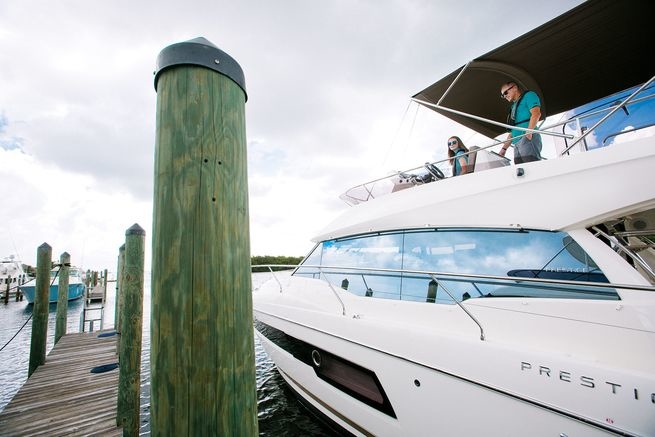
Welcome back.
I must admit, I thought winning the last competition - to return the boat to the parking lot - would be as easy for me as taking a candy from a child. My confidence increased when I realized what we had to do. We had to not just go aft to the pier, but first put the boat at a 45-degree angle to the pier and slip back into the narrow parking spot. At the same time, there was a pier on the port side with an indestructible obstacle and piles sticking out of the water on the starboard side.
My arrogance would have been no limit if it hadn't been for one thing: I was «»pretty sure that my child - my child - would now suffer from very expensive fiberglass. And - let's be honest - my checkbook is not very ready for this turn of events.
As a more experienced skipper, I was the first to start the mission. My own rule was spinning in my head, which said: move to the pier at a speed you're ready to face.
I figured out how much to wrap the stern, and only then did I start the maneuver. I cleverly bypassed the ominous corner of the pier and began to reverse to the breakwater. However, my decisive manner of driving played a bad role here: the boat started to be pulled down towards the piles. I quickly corrected the situation with my crown joystick's jerk in the opposite direction, but as one dude named Newton once said, there is always the same force opposition to any action, and I had to carefully adjust the movement of the boat again.
Most likely, for the yawns standing on the dock, it looked like a little hitch in my performance. But, like a teenager who was taking his first license, I felt that the examiner sitting next to me would take off for it. So I gave Riley the opportunity to win, and she took advantage of it willingly.
I tried hard to distract her and knock her out: complained about the unbearable heat, asked about the boys at school and even used a dirty trick from the series Golf Club (shouted at her
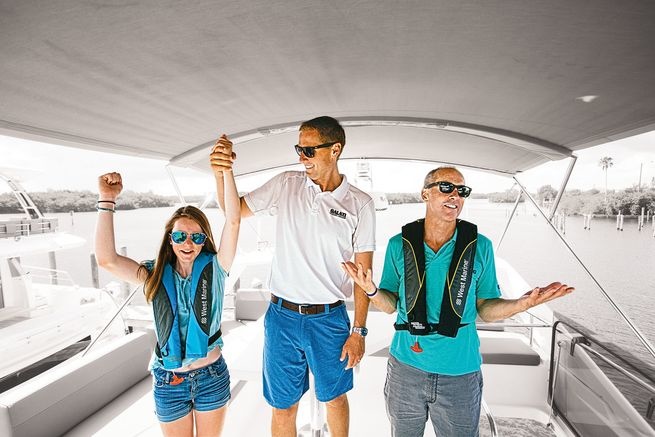
A
At that moment, I was crucified at the same time by the bitterness of defeat and pride in my child. And if a small one could do it, you can do it, even if you are an old sea wolf accustomed to the traditional gas/reverse handles.
The Boating magazine article was translated by Diana Karpovich especially for itBoat.

